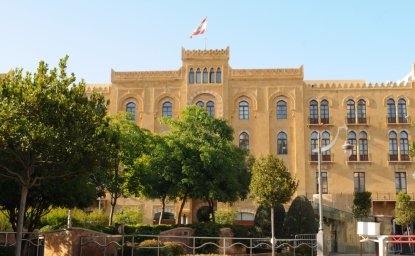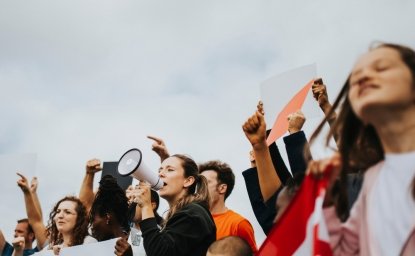
A blog of the Middle East Women's Initiative
In Iran, 44 years after the Islamic revolution, violence against women continues— not only in its physical form but intertwined with legal and social forms of violence.
A vivid memory of my childhood is hearing the screams of women in the neighborhood when walking to school or playing in the garden--women and girls being beaten by their husbands, brothers, and fathers. Two decades later, when I was working for the Women’s Organizations of Iran, my colleagues and I encountered battered women who came to our centers asking for help. The police, they told us, were not helpful.
Change came, however. Due to the efforts of the Women’s Organization, the Family Protection Law was passed, Family Protection Courts were established, and mistreated women acquired legal recourse. The courts gave women protection, and women, in turn, found the boldness to file complaints. With the spread of education, women grew more aware of their rights, more aware that violence against women should not be tolerated. Activist women began to consider legislation barring violence against women. In the last few years before the revolution, thanks to the Women’s Organization of Iran and its secretary general, Mahnaz Afkhami, the prevalence of violence against women became a much discussed subject in newspapers and women’s magazines.
In the mass demonstrations leading to the overthrow of the monarchy and the establishment of the Islamic Republic in 1979, one of the aspirations and hopes of the women participants, whether religious or secular, educated or with limited education, was equality under the law and the end to male supremacy in the family and the society.
These hopes were dashed under the Islamic Republic. Equality under the law was not enshrined in the new constitution. On the contrary, men were recognized as the heads of the family, and women lost the rights that they had acquired under the monarchy in matters of marriage, divorce, and child custody.
Persisting injustice
In Iran, 44 years after the Islamic revolution, violence against women continues— not only in its physical form but intertwined with legal and social forms of violence. When a government treats half its population as second-class citizens and disallows equality of women and men under the law, this is already a form of violence against women. In the early years of the revolution, more women were stoned for adultery in Iran than men. Both this barbaric law and honor killing of women remain on the books, but the latter is thankfully less widely enforced.
Immediately after the revolution, the government suspended the Family Protection Law--another act of violence against women. The age of marriage was reduced from 18 to 9 for girls. The right to seek a divorce was reserved for men only, allowing a husband to unilaterally divorce his wife, even if on a mere whim. Polygamy became once again legal. The hijab became mandatory, and not observing it was punishable by sixty lashes. I personally know four women who received the lashes, and there were numerous others. The Family Protection Courts were shut down and replaced, at first, by regular courts and eventually by family courts presided over by clerics. Judges hearing family disputes in these courts routinely favored the husband.
Under President Mohammad Khatami (1997-2005) and President Hassan Rouhani (2013-2021), there was an effort to pass a law dealing with violence against women. It was never enacted.
Struggle for equality
For the last forty years, women have been fighting these discriminatory laws, and in some cases, they have had small successes. After ten years of effort, women activists managed to raise the age of marriage for girls to 13. After being barred from some fields of study, all specializations at universities are once again open to women. Today, based on nationwide entrance examinations, more women gain admission to universities than men. Yet, when it comes to employment, men, still regarded as the official breadwinners, are given preference over women, particularly in the public sector.
In the social sphere, on the streets and public places, including coffee shops and restaurants, parks, and movie houses, the Morality Police target women far more than men for the manner of their dress or in whose company they appear. These police are empowered to arrest any person, young or old, for lack of proper hijab, too much makeup, and what they regard as improper attire. The case of Mahsa Amini, who was beaten to death by the Morality Police last year, led to an explosion of protests, which took all by surprise, both in Iran and abroad. The reaction of the government to the protest demonstrations was different—violence par excellence. Some 500 young men and women were killed, 20,000 were arrested and still linger in jail. Some young women and men were shot point blank in one eye—many observers thought deliberately to disfigure and to blind. Stories circulated of the rape of young women in prison. And all this was because a young woman had dared to show a bit of hair under her scarf.
Just two months ago, another young woman, 16-year-old Armita Geravand, was dragged out of the metro by the Morality Police for not observing the hijab; she too died in police custody. At her funeral, a number of women appeared without the hijab. Among them was Nasrine Sotoudeh, the famous Iranian human rights and women’s rights activist and lawyer. She was beaten, dragged into a police car, and taken to the Qarchak women’s prison, notorious for its primitive facilities (Qarchak used to be a chicken farm). Nasrine is the recipient of a number of prestigious human rights prizes in the US and Europe. She was released on bail after an international uproar over her arrest.
Nasrine and others stand as examples that Iranian women will not be deterred in their struggle for justice. Another activist, Nargess Mohammadi, is serving jail time in Evin prison, even while she suffers from a heart condition. In October, Nargess became the recipient of the 2023 Nobel Peace Prize—the second Iranian woman to be so honored. Such international recognition and honor of its women activists is not duplicated, appreciated, or welcomed by the Islamic Republic. On the contrary, Nargess remains in jail, and it is uncertain whether she will be released to receive the Nobel prize in person. Nasrine Sotoudeh might be summoned back to prison at any moment. Such is the treatment—the violence against women—in the Islamic Republic.
The views expressed in these articles are those of the author and do not reflect an official position of the Wilson Center.
Author


Middle East Program
The Wilson Center’s Middle East Program serves as a crucial resource for the policymaking community and beyond, providing analyses and research that helps inform US foreign policymaking, stimulates public debate, and expands knowledge about issues in the wider Middle East and North Africa (MENA) region. Read more

Explore More in Enheduanna
Browse Enheduanna
Women are the Catalysts for Change in Lebanon

How Education Can Empower Young Women in MENA


